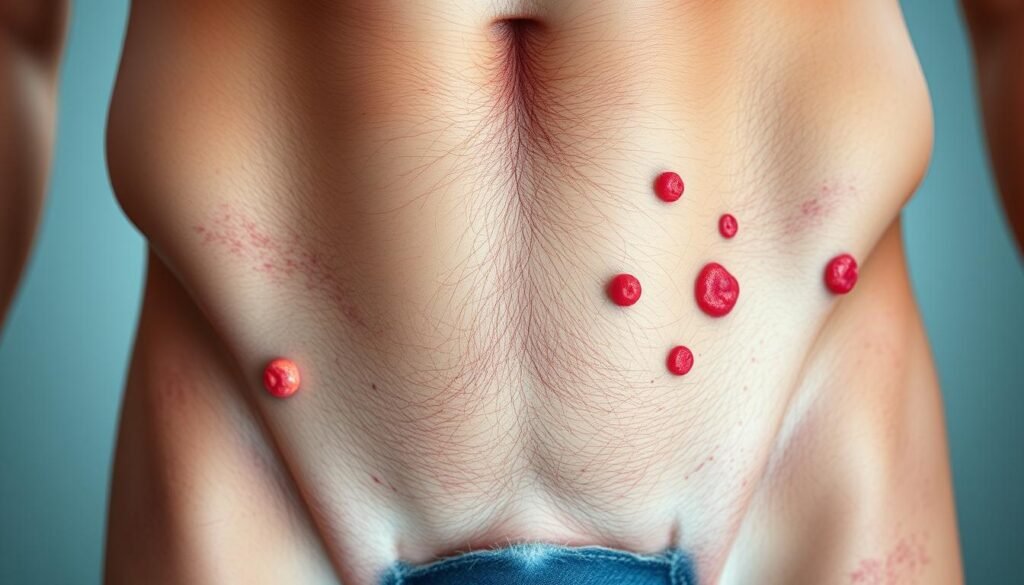Symptoms of STDs in Men: What to Look For
Did you know over 1 million STIs are caught every day worldwide? This is among people aged 15 to 49. The World Health Organization (WHO) says this is a big problem.
It’s important to take care of your health. Knowing male STD symptoms helps find problems early. Don’t wait to get tested if you feel something’s off.
Key Takeaways
- Over 1 million STIs are contracted daily among people aged 15 to 49.
- Recognizing STD symptoms in males is key for early detection.
- Being proactive about health can lower risks of problems.
- Getting tested quickly is important if you notice unusual symptoms.
- Knowing about male STD symptoms can improve your health.
Understanding STDs and Their Impact on Men’s Health
Sexually transmitted diseases (STDs) are a big worry for men’s health. Many infections are hidden because they don’t show symptoms. It’s key to know what STDs are, how common they are in men in the U.S., and why finding them early is important.
What Are Sexually Transmitted Diseases?
STDs, or STIs, are infections spread by sex. They can be caused by bacteria, viruses, or parasites. Common ones include chlamydia, gonorrhea, syphilis, herpes, and HIV.
Prevalence of STDs Among Men in the United States
STDs are a big health problem in the U.S., with millions of new cases each year. The CDC says men are hit hard by some STDs, like gonorrhea and syphilis.
Why Early Detection Matters
Many STDs don’t show symptoms. So, getting tested regularly is key. If not treated, STDs can cause serious problems like infertility, higher HIV risk, and cancer.
| STD | Common Symptoms | Complications if Untreated |
|---|---|---|
| Chlamydia | Often asymptomatic; may include urethral discharge or pain | Infertility, epididymitis |
| Gonorrhea | Urethral discharge, pain while urinating | Infertility, increased risk of HIV |
| Syphilis | Primary stage: genital sores; secondary stage: rash, fever | Neurological problems, organ damage |
Being proactive about your health is vital. Regular testing and awareness can greatly lower the risk of long-term health problems from STDs. Don’t delay getting tested.
Common STD Symptoms in Men
STD symptoms in men can be different. Knowing what to look for is key. Men should watch for signs and get medical help fast.
Urethral Discharge and Pain
Urethral discharge is a common sign. It often comes with pain or burning when you pee. Chlamydia and gonorrhea can cause this, along with itching or pain in the genital area.
Genital Sores, Rashes, and Lesions
Genital sores, rashes, or lesions can mean you have an STD. This could be herpes or syphilis. These can hurt and come back if not treated.
Systemic Symptoms: Fever, Fatigue, and Swollen Lymph Nodes
Some STDs cause fever, fatigue, and swollen lymph nodes. This happens when the infection spreads. It can affect other parts of your body too.
Asymptomatic Infections: The Silent Threat
Many STDs don’t show symptoms. This means men might not know they have an infection. Regular testing is very important, even if you don’t feel sick.
Knowing about these symptoms is vital for early treatment. Regular check-ups and safe practices can help a lot.
Chlamydia: The Most Reported Bacterial STD
Chlamydia is the most common bacterial STD. It’s a big health risk for men if not caught and treated. This STI spreads through sex without protection.
Recognizing Chlamydia Symptoms
Men with chlamydia might have discharge, burning while peeing, or testicle pain. But, many don’t show symptoms. So, getting tested often is key.
Complications if Left Untreated
Not treating chlamydia can cause big problems. It can lead to epididymitis, which might make a man infertile. It also raises the chance of getting HIV.
Testing and Treatment Options
Doctors use urine or swab tests to find chlamydia. Treatment is antibiotics. It’s also important to test and treat partners to avoid getting it again.
| Test Type | Description | Turnaround Time |
|---|---|---|
| Urine Test | Non-invasive test that detects chlamydia bacteria in urine. | 1-3 days |
| Swab Test | Sample taken from the urethra or other infected area. | 1-3 days |
Gonorrhea: Signs and Complications
Gonorrhea often doesn’t show symptoms in men. But, it can cause big health problems if not caught early. Most men with gonorrhea don’t show symptoms. But, when they do, it’s usually a week after they get infected.
Identifying Gonorrhea Symptoms
When gonorrhea in the urethra does show symptoms, they can be painful. You might see discharge or feel pain when you pee. You might also have swollen or painful testicles. It’s important to notice these signs and get help right away.

Antibiotic Resistance Concerns
Treating gonorrhea usually means using antibiotics. But, there’s a big worry about antibiotics not working anymore. This makes it very important to keep up with the latest treatment advice.
“The emergence of antibiotic-resistant Neisseria gonorrhoeae is a significant public health concern, necessitating dual antibiotic therapy for gonorrhea treatment.”
Long-term Health Risks
If gonorrhea is not treated, it can cause serious problems. These include epididymitis, prostatitis, and infertility. It can also make you more likely to get HIV.
| Complication | Description |
|---|---|
| Epididymitis | Inflammation of the epididymis, potentially causing pain and swelling. |
| Prostatitis | Inflammation of the prostate gland, which can lead to urinary and sexual dysfunction. |
| Infertility | Damage to the reproductive system, potentially affecting fertility. |
Knowing about gonorrhea’s signs and risks is key for men’s health. Getting tested regularly and treating it fast can stop long-term problems.
Syphilis: Stages and Symptoms
Syphilis has many stages. If not treated, it can cause serious health problems. It goes through four main phases: primary, secondary, latent, and tertiary. Each phase has its own symptoms and risks.
Primary Stage Symptoms
The first stage of syphilis shows up as a painless sore or ulcer. This sore, called a chancre, appears within three weeks of getting infected. It can last for weeks and is firm, round, and painless.
Secondary Stage Symptoms
If syphilis is not treated, it moves to its second stage. This stage brings symptoms like skin rashes, mouth sores, and swollen lymph nodes. The rash can be anywhere but often on hands and feet. You might also feel fever, tiredness, and hair loss.
Latent and Tertiary Stages
The latent stage has no visible symptoms, but the infection is there. This stage can last for years. If syphilis gets to the tertiary stage, it can harm many parts of the body, like the heart, brain, and nerves.
Neurosyphilis and Ocular Syphilis
Syphilis can also cause neurosyphilis, affecting the brain and nerves. Ocular syphilis harms the eyes and can cause blindness. Both need quick medical help.
Knowing the stages and symptoms of syphilis is key. It helps catch it early and treat it. This prevents long-term health issues and stops it from spreading to others.
Herpes: Recognizing Outbreaks
Knowing the signs of herpes is key to managing it well. Herpes is caused by a virus. It can make people feel quite uncomfortable.
HSV-1 vs. HSV-2 Symptoms
HSV-1 and HSV-2 are two herpes viruses. HSV-1 causes cold sores around the mouth. HSV-2 leads to sores in the genital area. But, both can show up in either place.
HSV-1 Symptoms: Cold sores, fever blisters, and sometimes genital sores.
HSV-2 Symptoms: Genital sores, pain when you pee, and sometimes fever and headache.
| Characteristics | HSV-1 | HSV-2 |
|---|---|---|
| Primary Location | Oral | Genital |
| Common Symptoms | Cold sores, fever blisters | Genital sores, painful urination |
| Possible Locations | Oral, genital | Genital, oral |
Initial vs. Recurrent Outbreaks
The first herpes outbreak is usually the worst. Later outbreaks are less severe. The first one can happen within days or weeks. It may include fever, headache, and swollen lymph nodes, along with sores.
Later outbreaks are milder. They can be triggered by stress, illness, or other things. It’s important to manage these outbreaks well.
“Understanding the triggers and taking proactive measures can significantly reduce the frequency and severity of herpes outbreaks.”
Managing Recurring Symptoms
Managing herpes symptoms involves antiviral meds, lifestyle changes, and stress control. Antiviral drugs can lessen outbreak severity and frequency. Safe sex and avoiding triggers also help.
Suppressive therapy, or daily antiviral meds, can cut down on outbreaks.
By knowing the symptoms and managing them well, people with herpes can live active, healthy lives.
HIV: Early and Late Symptoms
HIV infection shows different symptoms in early and late stages. Knowing these symptoms helps find and manage the disease early.
Acute HIV Infection Signs
The early stage of HIV, called acute HIV infection, feels like the flu. You might have fever, sore throat, and swollen lymph nodes. Some people get rashes or lesions on their skin. These signs usually start 2-4 weeks after getting infected.
Chronic HIV Symptoms
In the chronic stage, HIV symptoms may fade or not show up at all. But, some people feel always tired, lose weight, or get sick often. It’s important to get tested regularly during this time.
AIDS-Defining Conditions
If HIV is not treated, it can turn into AIDS. AIDS means your immune system is very weak. AIDS causes severe infections and some cancers.
Modern Treatment and Undetectable Status
Today’s treatments can make HIV levels undetectable. This makes life better and lowers the chance of spreading the virus. Sticking to treatment is key to keep the virus down.
HPV and Other Viral STDs in Men
HPV is a common STD in the U.S. It affects men’s health in many ways. Viral STDs like HPV, hepatitis B, and C are serious health risks. They can cause big problems if not treated.
Visual Symptoms of HPV and Genital Warts
HPV can cause genital warts. These are visible signs of the infection. They look like small, flat, or raised growths on the penis, scrotum, or around the anus.

Cancer Risks Associated with HPV
HPV is linked to cancers like penile, anal, and oropharyngeal cancers. This shows why vaccination and regular screening are so important.
Hepatitis B and C Symptoms
Hepatitis B and C are liver infections. Symptoms include jaundice, fatigue, and stomach pain. If not treated, they can cause liver cirrhosis and cancer.
- Jaundice: Yellowing of the skin and eyes
- Fatigue: Persistent feeling of tiredness
- Abdominal pain: Pain or discomfort in the liver area
It’s important for men to know about viral STDs like HPV, hepatitis B, and C. Regular tests, vaccines, and safe sex are key to staying healthy.
When and How to Get Tested for STDs
Knowing when and how to get tested for STDs is key to your health. Sexually transmitted diseases (STDs) are a big health issue. Getting tested is a big step in finding and treating them.
Recommended Testing Frequency
How often you should get tested for STDs depends on a few things. These include how active you are sexually and how many partners you have. The Centers for Disease Control and Prevention (CDC) says sexually active men under 25 should get tested for chlamydia and gonorrhea every year.
Men with many partners or who don’t use protection should test more often.
Types of STD Tests for Men
There are many tests for STDs in men. These include:
- Urine tests for chlamydia and gonorrhea
- Blood tests for HIV, syphilis, and hepatitis
- Urethral swabs for gonorrhea and chlamydia
Where to Get Tested
STD testing is available at many places. These include:
| Facility Type | Services Offered | Confidentiality |
|---|---|---|
| Primary Care Physician | Comprehensive STD testing | High |
| STD Clinics | Specialized STD testing and treatment | High |
| Urgent Care Centers | Rapid STD testing | High |
Understanding Test Results
It’s important to understand your STD test results. A positive result means you have an STD. A negative result means you don’t have one at the time of testing.
But, some STDs might not show up on tests right away. This is called the window period.
Always talk to a healthcare professional about your test results. They can explain what they mean and what treatment you might need.
Overcoming Barriers to STD Testing and Treatment
Men often face big challenges when they want to get tested for STDs. These challenges include feeling ashamed, worrying about privacy, and money problems.
Addressing Stigma and Embarrassment
Feeling too shy to get tested is common. It’s important to remember that STDs can happen to anyone.
Confidentiality and Privacy Concerns
Some men worry about who will know they got tested. But, many places offer secret testing.
Financial and Insurance Considerations
Money can be a big problem too. Luckily, many places offer free or cheap tests.
Talking to Partners About STDs
Talking about STDs with partners can be hard. But, it’s important for keeping everyone healthy.
| Barrier | Solution |
|---|---|
| Stigma | Education and awareness |
| Confidentiality concerns | Confidential testing services |
| Financial issues | Free or low-cost testing clinics |
Conclusion: Taking Control of Your Sexual Health
Knowing STD symptoms in men is very important. It helps keep your sexual health good. By knowing the signs, you can get help fast and avoid big problems later.
Getting tested often is important. It helps find and treat STDs early. Using protection, getting vaccines, and knowing about male STD symptoms can also help a lot.
Being proactive about your sexual health is key. Knowing the risks and taking steps to protect yourself and your partner is important. Stay informed, get tested often, and take care of your sexual health.
FAQ
What are the common symptoms of STDs in men?
Symptoms include discharge, sores, rashes, and fever. Some STDs don’t show symptoms. So, it’s key to get tested often.
How can I identify if I have chlamydia?
Look for discharge, burning when you pee, and testicle pain. But, many men with chlamydia don’t show signs. So, testing is very important.
What are the risks if gonorrhea is left untreated?
Untreated gonorrhea can cause serious problems. These include epididymitis, prostatitis, and a higher HIV risk. It can also lead to infertility and a dangerous infection.
What are the stages of syphilis and their symptoms?
Syphilis has four stages. The first is sores, the second is rash and fever, the third is no symptoms, and the fourth is serious problems. Neurosyphilis and ocular syphilis can happen at any time.
How can I manage herpes outbreaks?
Use antiviral meds to lessen outbreaks. Keep clean and avoid stress. For often outbreaks, try suppressive therapy.
What are the early symptoms of HIV?
Early HIV symptoms feel like the flu. They include fever, rash, sore throat, and muscle pain. Many don’t show symptoms early. So, getting tested is key.
How often should I get tested for STDs?
Test frequency depends on your activity and risk. Sexually active men should test yearly for chlamydia, gonorrhea, and syphilis. Test more often with many partners or without protection.
What types of tests are available for STDs?
Tests include urine, blood, and swab tests. The test type varies by STD and symptoms. Some tests check for many infections at once.
How can I overcome the stigma associated with STD testing?
Recognize STDs are common and testing is smart. Keep testing private. Talk about STDs with partners to reduce stigma and promote health.
What are the cancer risks associated with HPV?
HPV can lead to anal, penile, and throat cancers. Vaccination can lower this risk. Regular screening can catch these cancers early.
Can I get treated for an STD if I don’t have insurance?
Yes, many clinics offer free or low-cost testing and treatment. Community health centers, Planned Parenthood, and local health departments help.


